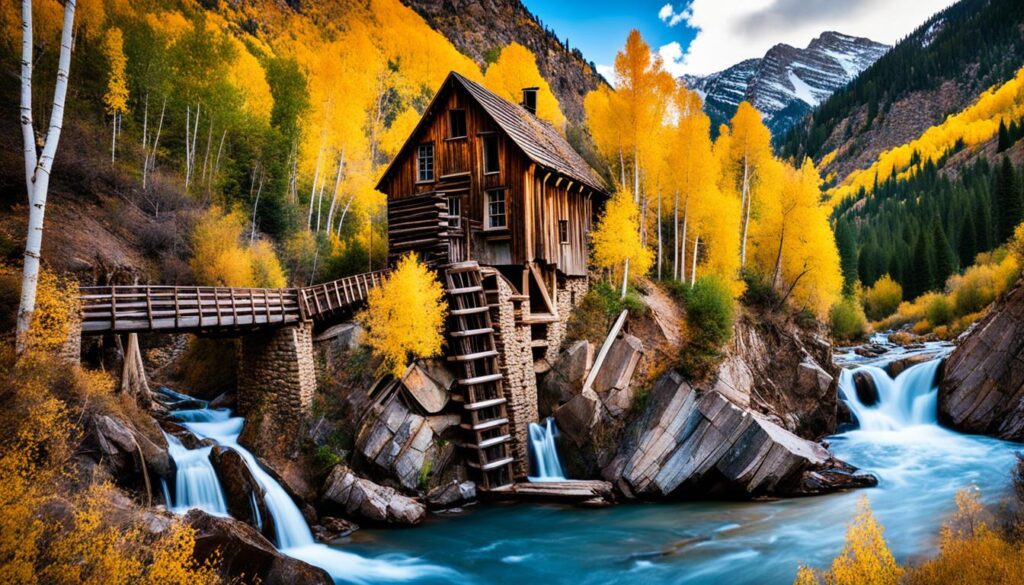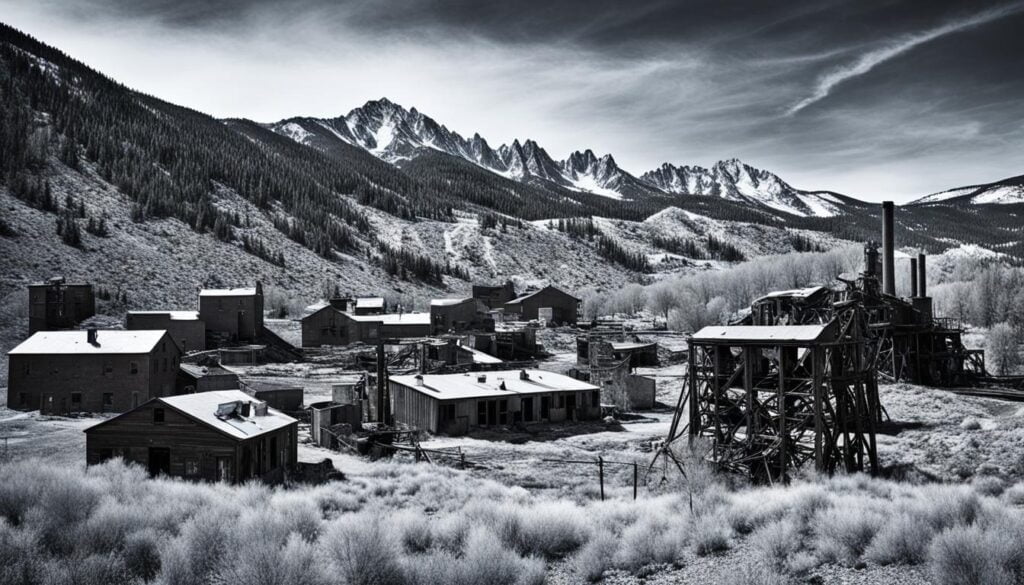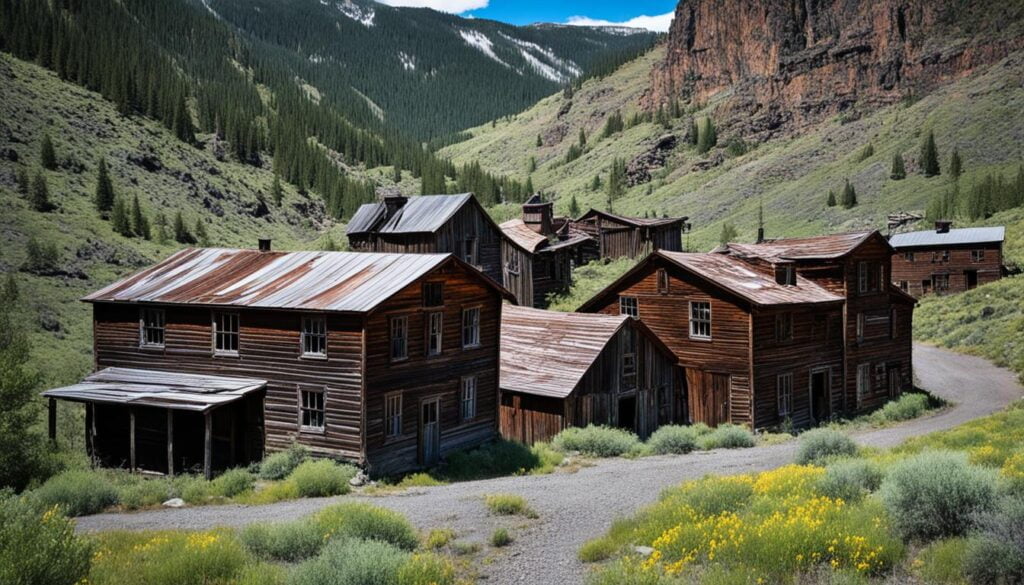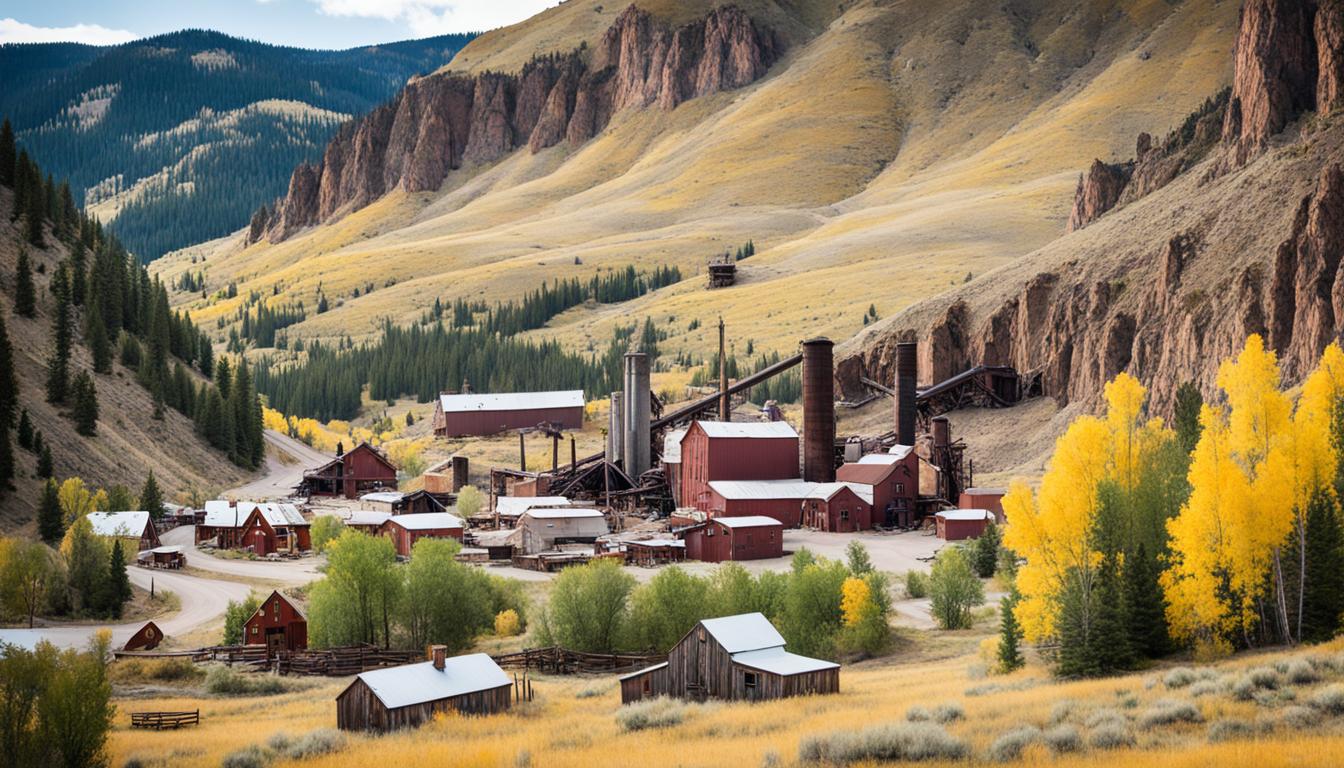Step Back in Time: Unearth Colorado’s Forgotten Mining Towns
Have you ever wondered what it was like to live during the gold rush era? Or how people survived in the inhospitable conditions of Colorado’s rugged mountains? Join us on a journey through time as we explore Colorado’s forgotten mining towns, where dreams of wealth clashed with the harsh realities of life.
Key Takeaways:
- Colorado’s historic mining towns offer a fascinating glimpse into the state’s gold rush history.
- These towns were often abandoned once the ore ran out, leaving behind remnants of their mining past.
- Visiting ghost towns allows us to understand the hardships faced by Colorado’s pioneers.
- Exploring mine sites, scenic trails, and preserved buildings offers a unique experience for history enthusiasts.
- Uncover captivating stories of success and failure as you step back in time and unearth Colorado’s forgotten mining towns.
Bachelor Loop, Creede: Exploring the Last Mining Boom in Colorado
Creede, a town nestled in the picturesque San Juan Mountains, played a significant role in Colorado’s mining history during the late 1800s. Known for its short-lived but impactful mining boom, this charming town continues to captivate visitors with its rich heritage and well-preserved mine sites.
The highlight of Creede’s mining past is undoubtedly the scenic Bachelor Loop, a 17-mile journey that takes you through the heart of this historic area. The loop offers an immersive experience, combining breathtaking landscapes with fascinating insights into the mining operations that once thrived here.
As you traverse the Bachelor Loop, you’ll come across interpretive signs and stops of interest, providing a deeper understanding of Creede’s mining heritage. These informative markers shed light on the challenges faced by miners, the impact of the mining boom, and the town’s eventual decline.
If you prefer a leisurely exploration, you can embark on the Bachelor Loop by car. The well-maintained road allows you to soak in the stunning scenery while making stops at various points of interest along the way.
For those seeking a more adventurous experience, consider taking the side roads that lead deeper into the rugged terrain of the San Juan Mountains. A four-wheel-drive vehicle is recommended for these off-road routes, providing access to hidden gems and lesser-known mine sites that showcase Creede’s fascinating mining history.
“The Bachelor Loop offers a remarkable journey through Creede’s mining boom era, giving visitors a chance to step back in time and connect with the region’s historical roots.” – Local Historian
Exploring Creede’s Mine Sites
Creede’s mine sites are the star attractions along the Bachelor Loop. These well-preserved remnants offer a glimpse into the once-thriving industry that sustained the town.
| Mine Site | Location | Description |
|---|---|---|
| Amethyst Mine | Near Creede | Known for its deposits of high-quality amethyst, this mine was a significant source of gemstones during Creede’s mining boom. |
| Creede Underground Mining Museum | Creede | Housed in an old mine building, the museum offers a comprehensive look into the town’s mining history through exhibits and guided tours. |
| Homestake Mine | Near Bachelor Loop | One of the most significant silver producers in Colorado’s mining history, this mine boasts extensive underground tunnels. |
| Snowshoe Mine | Near Bachelor Loop | Famous for its impressive wooden headframe and intact mining structures, the Snowshoe Mine provides a unique opportunity to witness the engineering marvels of the past. |
Whether you’re a history enthusiast, photography lover, or nature seeker, Creede and its enchanting Bachelor Loop offer an unforgettable experience. Embark on this journey to unravel the stories of Colorado’s mining past and discover the indelible mark left by the last mining boom in the state.
Crystal Mill: A Picturesque Relic of Colorado’s Mining Past

The Crystal Mill, located near Marble, Colorado, is an iconic and picturesque landmark that stands as a testament to the state’s rich mining history. Once an integral part of the Sheep Mountain Tunnel mine, this historic mill played a vital role in generating compressed air for miners’ tools. Built in 1893, the Crystal Mill served as a crucial hub of activity during its operational years.
Although the mine itself closed its doors in 1917, the Crystal Mill continues to captivate visitors from near and far. Nestled in the scenic surroundings near Marble, this relic of the past attracts explorers and history enthusiasts who seek to immerse themselves in Colorado’s fascinating mining heritage.
Accessing the Crystal Mill is an adventure in itself. Visitors can choose from two options: a sturdy vehicle capable of traversing rugged terrain or a picturesque 4-mile hike along a scenic road. Both routes offer breathtaking views of the surrounding mountains and forests, setting the stage for a memorable journey back in time.
It’s important to note that the Crystal Mill is located on private property, and visitors must respect the restrictions in place. By abiding by the regulations, we can ensure that this remarkable piece of history remains accessible to future generations.
Stepping foot in the Crystal Mill’s vicinity not only allows us to appreciate the engineering marvels of the past but also provides a glimpse into the lives of the miners who toiled away to extract valuable resources from the earth. Whether you choose to explore the mill by vehicle or embark on a scenic hike, the Crystal Mill promises an unforgettable experience that transports you back to the height of Colorado’s mining era.
Ghost Town Hollow: Exploring Failed Mining Endeavors on Pikes Peak

Ghost Town Hollow, located at about 11,800 feet elevation on Pikes Peak, offers a fascinating glimpse into the remnants of a failed mining endeavor. The settlement’s cabin foundations and old boilers stand as silent witnesses to the ambitious attempts to blast a tunnel into the heart of the mountain.
Although the mining efforts here were unsuccessful, this ghost town still holds historical significance and captivates those who venture to explore its mining relics. The rugged terrain and high altitude serve as a constant reminder of the challenges faced by the miners who sought their fortunes on Pikes Peak.
To reach Ghost Town Hollow, visitors can take the scenic Pikes Peak Highway and embark on a 1.4-mile hike. The hike not only leads to the remnants of the failed mining site but also rewards hikers with breathtaking mountain views along the way.
Exploring Ghost Town Hollow allows a deeper understanding of the trials and tribulations experienced by those involved in mining at such high altitudes. It is a reminder of the resilience and determination that shaped Colorado’s mining history.
Key Highlights of Ghost Town Hollow:
- Location: Pikes Peak, Colorado
- Elevation: Approximately 11,800 feet
- Historical Significance: Failed mining endeavor with cabin foundations and old boilers
- Access: Pikes Peak Highway, followed by a 1.4-mile hike
- Scenic Views: Breathtaking mountain vistas along the hiking trail
Exploring Ghost Town Hollow on Pikes Peak provides a unique opportunity to witness the remnants of a failed mining venture while immersing oneself in the natural beauty of Colorado’s mountains. The site serves as a testament to the bold spirit and perseverance of the early miners who shaped the state’s rich mining history.
Holy Cross City: A Challenging Journey to a Forgotten Mining Town

Located near the majestic Mount of the Holy Cross, Holy Cross City is a hidden gem that takes visitors on a daring adventure back in time. This once thriving mining town, with its post office and hotel, was home to a bustling community of 300 people. Today, reaching this remote destination is no easy feat, as the rugged terrain and the infamous Holy Cross Jeep Trail pose a thrilling challenge.
For those seeking an adrenaline-pumping experience, driving the Holy Cross Jeep Trail is the ultimate test of skill and nerve. This treacherous four-wheel-drive road is not for the faint of heart, featuring steep ascents, heart-stopping descents, and boulder-strewn paths. Embarking on this off-road expedition guarantees breathtaking scenery and an unmatched adrenaline rush.
Alternatively, outdoor enthusiasts can choose to lace up their hiking boots and tackle the 4-mile road on foot. The hike to Holy Cross City offers a chance to immerse oneself in the untamed beauty of the surrounding wilderness, with panoramic views of the towering peaks and serene alpine meadows along the way.
“Driving the Holy Cross Jeep Trail or hiking the road to Holy Cross City offers a thrilling journey that transports visitors to a bygone era of mining glory.” – Local Adventurer Magazine
Upon arriving at Holy Cross City, a remarkable sight awaits. Amidst the picturesque landscape, visitors will find semi-intact buildings that served as homes and businesses during the town’s heyday. Walking through the remnants of this forgotten mining town feels like stepping back in time, as the echoes of the past whisper tales of hardworking miners and ambitious dreams.
Exploring Holy Cross City allows adventurers to discover firsthand the remnants of mining equipment, witnessing the perseverance and ingenuity of the pioneers who once called this place home. From rusted tools to dilapidated structures, these artifacts offer a glimpse into the hardships faced and the triumphs achieved by those who built their lives in this remote frontier.
Conclusion
Exploring Colorado’s historic mining towns offers a fascinating glimpse into the state’s rich gold rush history. These towns, once bustling with activity, now stand as reminders of the hardships faced by early pioneers in their quest for precious metals. From the boom towns that sprung up overnight to the remnants of failed mining endeavors, these ghost towns tell captivating stories of triumph and disappointment.
Visitors have the opportunity to immerse themselves in the past by discovering preserved mine sites and exploring scenic trails. As they wander through the abandoned streets and buildings, they can imagine the rush of excitement that once filled the air during the gold rush era. The preserved artifacts and mining equipment offer a tangible connection to the pioneers who labored in harsh conditions to extract the riches from the earth.
Colorado’s mining history is a journey through time, filled with tales of perseverance and adventure. The state’s historic mining towns allow visitors to step back in time and experience the thrill of the gold rush firsthand. Whether it’s driving along the Bachelor Loop in Creede or hiking to the remote Holy Cross City, each town has its own unique story to tell. Don’t miss the opportunity to unearth Colorado’s forgotten mining towns and be transported to an era filled with excitement, discovery, and untold stories.







